CNT:TiO2-Doped Spiro-MeOTAD/Selenium Foam Heterojunction for High-Stability Self-Powered Broadband Photodetector
Abstract
1. Introduction
2. Materials and Methods
3. Results
4. Conclusions
Supplementary Materials
Author Contributions
Funding
Data Availability Statement
Conflicts of Interest
References
- Wang, Z.; Yin, Z.; Yang, Z.; Shan, F.; Huang, J. Research progress of self-powered photodetectors based on halide perovskites. Chem. Eng. J. 2024, 501, 157512. [Google Scholar] [CrossRef]
- Liu, Y.; Gao, Y.; Zhi, J.; Huang, R. All-inorganic lead-free NiOx/Cs3Bi2Br9 perovskite heterojunction photodetectors for ultraviolet multispectral imaging. Nano Res. 2022, 15, 1094–1101. [Google Scholar] [CrossRef]
- Kim, S.; Kim, M.; Kim, H. Self-powered photodetectors based on two-dimensional van der Waals semiconductors. Nano Energy 2024, 127, 109725. [Google Scholar] [CrossRef]
- Kajli, S.K.; Ray, D.; Roy, S.C. Efficient UV–visible photodetector based on single CuO/Cu2O core-shell nanowire. J. Alloys. Compd. 2022, 895, 162546. [Google Scholar] [CrossRef]
- Salih, E.Y.; Hasan, S.I.; SalahAlden, E.D. Optoelectronic characteristics of solution processed NiO/CdS/ITO photodetector for dual-wavelength detection. Sens. Actuators A Phys. 2025, 390, 116560. [Google Scholar] [CrossRef]
- Giang, D.N.; Nguyen, N.M.; Ngo, D.A.; Tran, T.T.; Duy, L.T.; Tran, C.K.; Dang, V.Q. A visible-light photodetector based on heterojunctions between CuO nanoparticles and ZnO nanorods. Beilstein J. Nanotechnol. 2023, 14, 1018–1027. [Google Scholar] [CrossRef]
- McCulloch, I.; Heeney, M.; Chabinyc, M.L.; DeLongchamp, D.; Kline, R.J.; Cölle, M. Semiconducting thienothiophene copolymers: Design, synthesis, morphology, and performance in thin-film organic transistors. Adv. Mater. 2009, 21, 1091–1109. [Google Scholar] [CrossRef]
- Fan, Q.; Zhang, K.; Peng, S.; Liu, Y.; Wei, L.; Qin, S. The mechanism of enhancing the conductivity of PEDOT: PSS films through molecular weight optimization of PSS. Prog. Org. Coat. 2024, 189, 108308. [Google Scholar] [CrossRef]
- Zhou, S.; Yu, L.; Yang, Q.; Liu, C.; Xie, W.; Xue, K.; Li, Z.; Zhang, Y.; Zhu, H. Enhanced photocatalyst performance by promoting carrier separation: CuNi2S4-ZnCdS nano-contact heterojunctions. J. Alloys Compd. 2025, 1017, 179177. [Google Scholar] [CrossRef]
- Ge, Y.; Lei, D.; Zhang, C.; Zhang, Q.; Mu, J.; Li, J. Solution-processable Van Der Waals heterojunctions on Silicon for self-powered photodetectors with high responsivity and detectivity. Adv. Sci. 2025, 2500027. [Google Scholar] [CrossRef]
- Zhou, X.; Yu, G. Preparation engineering of two-dimensional heterostructures via bottom-up growth for device applications. ACS Nano 2021, 15, 11040–11065. [Google Scholar] [CrossRef] [PubMed]
- Sun, J.; Lin, Z.; Jia, X.; Li, H.; Song, C.; Pan, F.; Fang, L.; Zhang, J.; Wang, Y. High-performance 2D WS2 photodetector enhanced by charge-transfer doping through NH3 annealing. Mater. Today Phys. 2023, 35, 101133. [Google Scholar] [CrossRef]
- Tang, H.; Neupane, B.; Neupane, S.; Ruan, S.; Nepal, N.K.; Ruzsinszky, A. Tunable band gaps and optical absorption properties of bent MoS2 nanoribbons. Sci. Rep. 2022, 12, 3008. [Google Scholar] [CrossRef] [PubMed]
- Zhou, C.; Ai, Q.; Chen, X.; Gao, X.; Liu, K.; Shen, D. Ultraviolet photodetectors based on wide bandgap oxide semiconductor films. Chin. Phys. B 2019, 28, 048503. [Google Scholar] [CrossRef]
- Zhou, X.; Lu, Z.; Zhang, L.; Ke, Q. Wide-bandgap all-inorganic lead-free perovskites for ultraviolet photodetectors. Nano Energy 2023, 117, 108908. [Google Scholar] [CrossRef]
- Wang, J.; Lee, S. Ge-Photodetectors for Si-Based Optoelectronic Integration. Sensors 2011, 11, 696–718. [Google Scholar] [CrossRef]
- Meng, Y.; Wang, W.; Fan, R. An inorganic-blended p-type semiconductor with robust electrical and mechanical properties. Nat. Commun. 2024, 15, 4440. [Google Scholar] [CrossRef]
- Veeralingam, S.; Borse, P.; Badhulika, S. High responsivity self-powered flexible broadband photodetector based on hybrid Selenium-PEDOT: PSS junction. Org. Electron. 2022, 108, 106586. [Google Scholar]
- Vijayakumar, S.; Chen, J.; Divya, M.; Durán-Lara, E.F.; Prasannakumar, M.; Vaseeharan, B. A Review on biogenic synthesis of selenium nanoparticles and its biological applications. J. Inorg. Organomet. Polym. Mater. 2022, 32, 2355–2370. [Google Scholar] [CrossRef]
- Zhang, X.Y.; Xu, L.H.; Dai, J.Y.; Cai, Y.; Wang, N. Synthesis and characterization of single crystalline selenium nanowire arrays. Mater. Res. Bull. 2006, 41, 1729–1734. [Google Scholar] [CrossRef]
- Filippo, E.; Manno, D.; Serra, A. Aligned selenium microtubes array: Synthesis, growth mechanism and photoelectrical properties. Chem. Phys. Lett. 2011, 510, 87–92. [Google Scholar] [CrossRef]
- Hu, K.; Chen, H.; Jiang, M.; Teng, F.; Zheng, L.; Fang, X. Broadband photoresponse enhancement of a high-performance t-Se microtube photodetector by plasmonic metallic nanoparticles. Adv. Funct. Mater. 2016, 26, 6641–6648. [Google Scholar] [CrossRef]
- Hu, K.; Teng, F.; Zheng, L.; Yu, P.; Zhang, Z.; Chen, H.; Fang, X. Binary response Se/ZnO p-n heterojunction UV photodetector with high on/off ratio and fast speed. Laser Photonics Rev. 2016, 11, 1600257. [Google Scholar] [CrossRef]
- Yu, P.; Hu, K.; Chen, H.; Zheng, L.; Fang, X. Novel p–p heterojunctions self-powered broadband photodetectors with ultrafast speed and high responsivity. Adv. Funct. Mater. 2017, 27, 1703166. [Google Scholar] [CrossRef]
- Yu, P.; Du, Q.; Zheng, T.; Wang, W.; Wan, X.; Jiang, Y. Reduced graphene oxide/Se Microtube p–p heterojunction for self-powered UV–NIR broadband photodetectors. ACS Appl. Nano Mater. 2024, 7, 5103–5112. [Google Scholar] [CrossRef]
- Zheng, T.; Du, Q.; Wang, W.; Duan, W.; Feng, S.; Chen, R.; Wan, X.; Jiang, Y.; Yu, P. High performance and self-powered photodetectors based on Se/CsPbBr3 heterojunctions. J. Mater. Chem. C 2023, 11, 3841–3847. [Google Scholar] [CrossRef]
- Pasupuleti, K.S.; Reddeppa, M.; Park, B.G.; Peta, K.R.; Oh, J.E.; Kim, S.G.; Kim, M.D. Ag nanowire-plasmonic-assisted charge separation in hybrid heterojunctions of Ppy-PEDOT: PSS/GaN nanorods for enhanced UV photodetection. ACS Appl. Mater. Interfaces 2020, 12, 54181–54190. [Google Scholar] [CrossRef]
- Huang, J.T.; Lin, Y.M.; Yu, J.L.; Li, D.Z.; Du, J.G. N-doped foam flame retardant polystyrene derived porous carbon as an efficient scaffold for lithium-selenium battery with long-term cycling performance. Chem. Eng. J. 2018, 350, 411–418. [Google Scholar] [CrossRef]
- Zhao, X.; Jiang, L.; Ma, C.; Cheng, L.; Wang, C.; Chen, G.; Yue, H.; Zhang, D. The synergistic effects of nanoporous fiber TiO2 and nickel foam interlayer for ultra-stable performance in lithium-selenium batteries. J. Power Sources 2021, 490, 229534. [Google Scholar] [CrossRef]
- Zhang, X.; Liu, B.; Liu, Q.; Yang, W.; Xiong, C. Ultrasensitive and highly selective photodetections of UV-A rays based on individual bicrystalline GaN nanowire. ACS Appl. Mater. Interfaces 2017, 9, 2669–2677. [Google Scholar] [CrossRef]
- Chang, R.; Xu, Q.; Yin, Q.; Yang, X.; Wu, Z.; Shen, H. High-performance photodiodes based on in-situ etched PbSe colloidal quantum dots with responses extended to 2500 nm. Nano Lett. 2024, 11, 696–718. [Google Scholar] [CrossRef] [PubMed]
- Zhang, S.; An, S.; Dai, M.; Wu, Q.Y.S.; Adanan, N.Q.; Zhang, J.; Liu, Y.; Lee, H.Y.L.; Wong, N.L.M.; Suwardi, A.; et al. Chalcogenide metasurfaces enabling ultra-wideband detectors from visible to mid-infrared. Adv. Sci. 2025, 12, 2413858. [Google Scholar] [CrossRef] [PubMed]
- Yan, Z.; Li, S.; Liu, Z.; Zhi, Y.; Dai, J.; Sun, X.; Sun, S.; Guo, D.; Wang, X.; Li, P.; et al. High sensitivity and fast response self-powered solar-blind ultraviolet photodetector with a β-Ga2O3/spiro-MeOTAD p–n heterojunction. J. Mater. Chem. C 2020, 8, 4502–4509. [Google Scholar] [CrossRef]
- Xie, Y.; Wei, L.; Li, Q.; Wei, G.; Wang, D.; Chen, Y.; Jiao, J.; Yan, S.; Liu, G.; Mei, L. Self-powered solid-state photodetector based on TiO2 nanorod/spiro-MeOTAD heterojunction. Appl. Phys. Lett. 2013, 11, 696–718. [Google Scholar] [CrossRef]
- Huang, L.; Wu, L.; Sun, Q.; Jin, C.; Wang, J.; Fu, S.; Wu, Z.; Liu, X.; Hu, Z.; Zhang, J.; et al. All in one: A versatile n-Perovskite/p-Spiro-MeOTAD p–n heterojunction diode as a photovoltaic cell, Photodetector, and Memristive Photosynapse. J. Phys. Chem. Lett. 2021, 12, 12098–12106. [Google Scholar] [CrossRef]
- Yan, Z.; Li, S.; Yue, J.; Liu, Z.; Ji, X.; Yang, Y.; Li, P.; Wu, Z.; Guo, Y.; Tang, W. A Spiro-MeOTAD/Ga2O3/Si p-i-n junction featuring enhanced self-powered solar-blind sensing via balancing absorption of photons and separation of photogenerated carriers. ACS Appl. Mater. Interfaces 2021, 13, 57619–57628. [Google Scholar] [CrossRef]
- Jeong, S.Y.; Kim, H.S.; Park, N.G. Challenges for thermally stable Spiro-MeOTAD toward the market entry of highly efficient perovskite solar cells. ACS Appl. Mater. Interfaces 2022, 14, 34220–34227. [Google Scholar] [CrossRef]
- Grotevent, M.J.; Lu, Y.; Šverko, T. Additive-free oxidized Spiro-MeOTAD hole transport layer significantly improves thermal solar cell stability. Adv. Energy Mater. 2024, 14, 2400456. [Google Scholar] [CrossRef]
- Saygili, Y.; Kim, H.S.; Yang, B.; Suo, J.; Muñoz-Garcia, A.B.; Pavone, M.; Hagfeldt, A. Revealing the mechanism of doping of spiro-meotad via Zn complexation in the absence of oxygen and light. ACS Energy Lett. 2020, 5, 1271–1277. [Google Scholar] [CrossRef]
- Chen, Y.Z.; You, Y.T.; Chen, P.J.; Li, D.; Su, T.Y.; Lee, L.; Shih, Y.C.; Chen, C.W.; Chang, C.C.; Wang, Y.C.; et al. Environmentally and mechanically stable selenium 1D/2D hybrid structures for broad-range photoresponse from ultraviolet to infrared wavelengths. ACS Appl. Mater. Interfaces 2018, 10, 35477–35486. [Google Scholar] [CrossRef]
- Liu, Z.; Xi, M.; Sheng, R.; Huang, Y.; Ding, J.; Tan, Z.; Li, J.; Zhang, W.; Wang, Y. Zn(TFSI)2-mediated ring-opening polymerization for electrolyte engineering toward stable aqueous zinc metal batteries. Nano-Micro Lett. 2025, 17, 120. [Google Scholar] [CrossRef]
- Lou, Q.; Li, H.; Huang, Q.; Shen, Z.; Li, F.; Du, Q.; Jin, M.; Chen, C. Multifunctional CNT:TiO2 additives in spiro-OMeTAD layer for highly efficient and stable perovskite solar cells. EcoMat 2021, 3, 12099. [Google Scholar] [CrossRef]
- Amrani, R.; Lekoui, F.; Garoudja, E.; Zenati, Y.; Hamri, A.; Filali, W.; Hassani, S. Structural and optical properties of highly Ag-doped TiO2 thin films prepared by flash thermal evaporation. Phys. Scr. 2024, 99, 065914. [Google Scholar] [CrossRef]
- Jabeen, N.; Xia, Q.; Yang, M.; Xia, H. Unique core–shell nanorod arrays with polyaniline deposited into mesoporous NiCo2O4 support for high-performance supercapacitor electrodes. ACS Appl. Mater. Interfaces 2016, 8, 6093–6100. [Google Scholar] [CrossRef] [PubMed]
- Game, O.; Singh, U.; Kumari, T.; Banpurkar, A.; Ogale, S. ZnO (N)–Spiro-MeOTAD hybrid photodiode: An efficient self-powered fast-response UV (visible) photosensor. Nanoscale 2014, 6, 503–513. [Google Scholar] [CrossRef]
- Seo, J.; Kim, Y.J.; Yoo, H. Zero bias operation: Photodetection behaviors obtained by emerging materials and device structures. Micromachines 2022, 13, 2089. [Google Scholar] [CrossRef]
- Vashishtha, P.; Abidi, I.H.; Giridhar, S.P.; Verma, A.K.; Prajapat, P.; Bhoriya, A.; Walia, S. CVD-grown monolayer MoS2 and GaN thin film heterostructure for a self-powered and bidirectional photodetector with an extended active spectrum. ACS Appl. Mater. Interfaces 2024, 16, 31294–31303. [Google Scholar] [CrossRef]
- Vashishtha, P.; Prajapat, P.; Kumar, K.; Kumar, M.; Walia, S.; Gupta, G. Multiband spectral response inspired by ultra-high responsive thermally stable and self-powered Sb2Se3/GaN heterojunction based photodetector. Surf. Interfaces 2023, 42, 103376. [Google Scholar] [CrossRef]
- Zhang, S.; Wang, H.; Pan, W.; Luo, H.; Ren, Y.; Liang, Y.; Lei, W. Polarization-sensitive near-infrared photodetectors based on quasi-one-dimensional Sb2Se3 nanotubes. J. Alloys. Compd. 2023, 937, 168284. [Google Scholar] [CrossRef]
- Kumar, M.; Rani, S.; Yadav, R.; Singh, Y.; Singh, M.; Husale, S.; Singh, V.N. Large area, self-powered, flexible, fast, and broadband photodetector enabled by the SnSe-Sb2Se3 heterostructure. Surf. Interfaces 2022, 30, 101964. [Google Scholar] [CrossRef]
- Li, K.; Yang, X.; Yang, F.; He, J.; Zhang, G.; Jiang, S.; Tang, J. Flexible short-wavelength infrared photodetector based on extrinsic Sb2Se3. Mater. Today Electron. 2022, 2, 100011. [Google Scholar] [CrossRef]

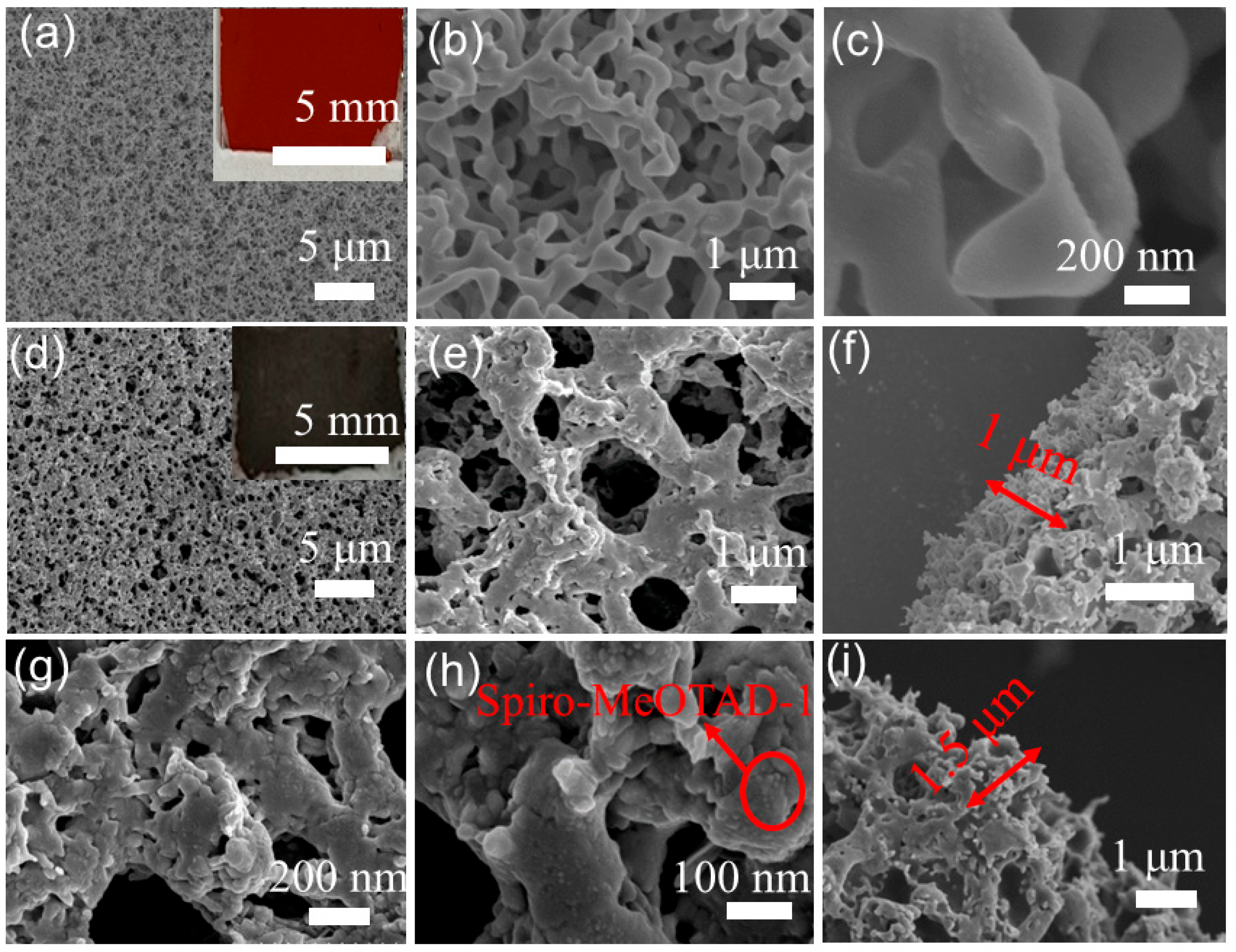
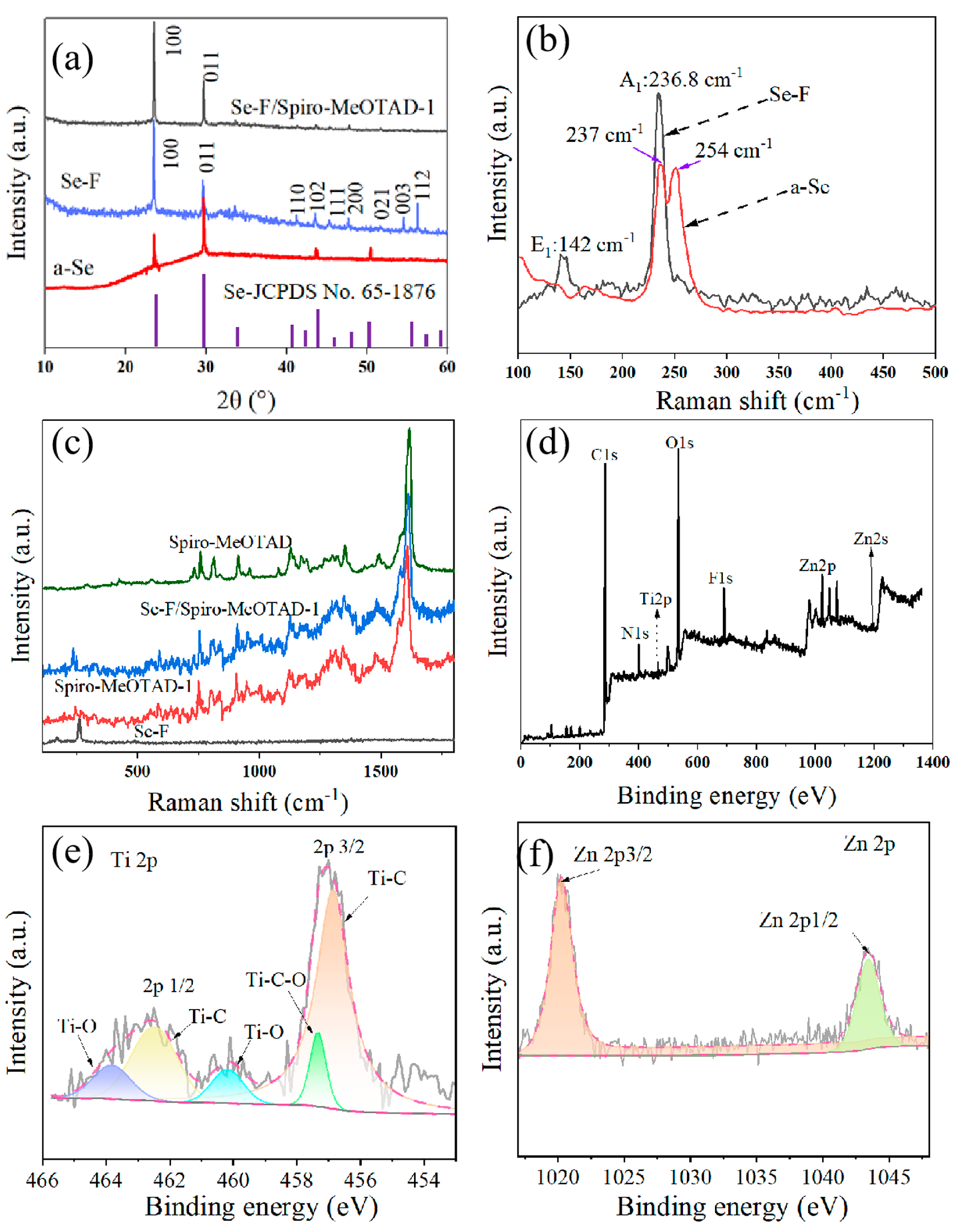

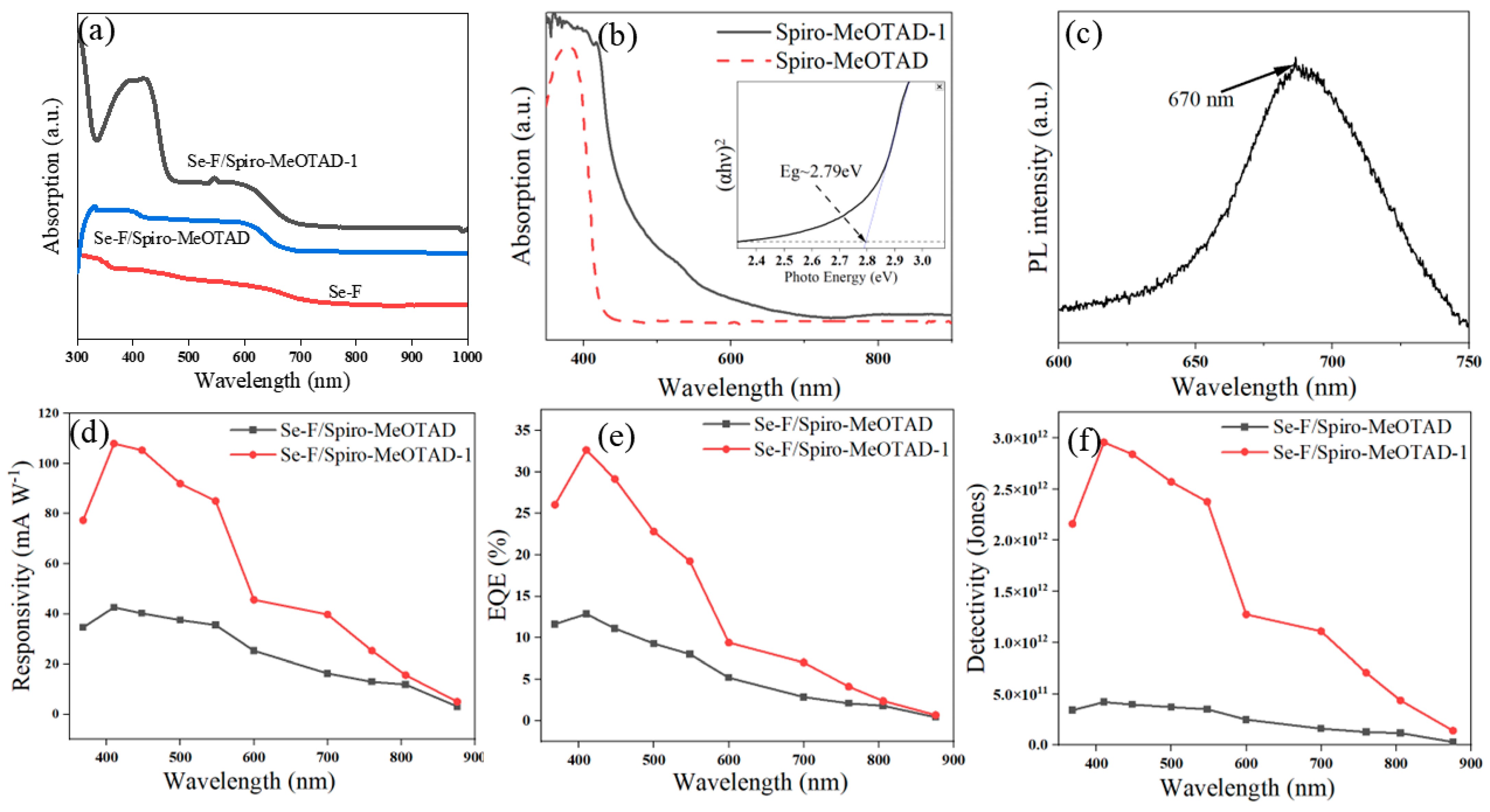
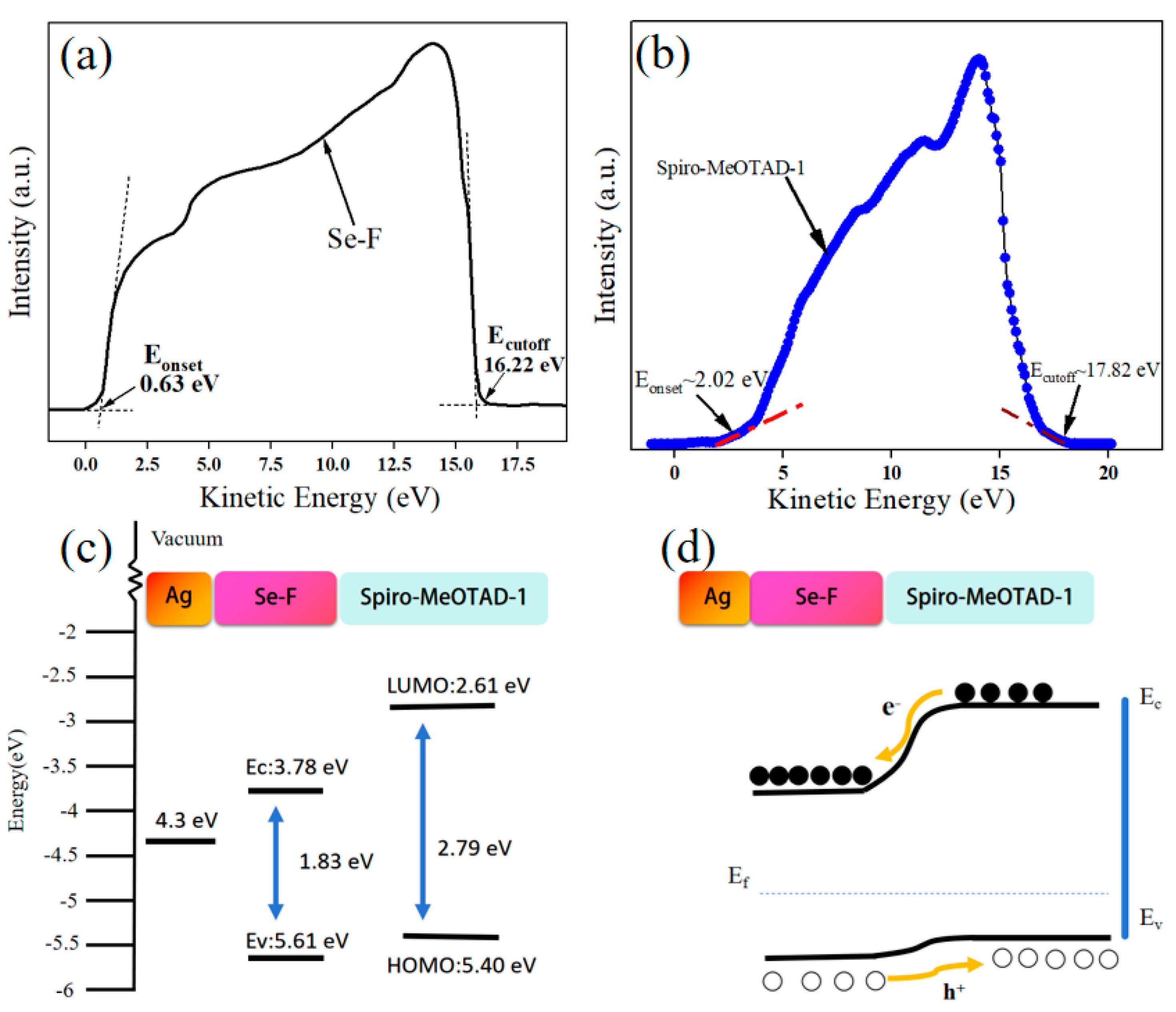


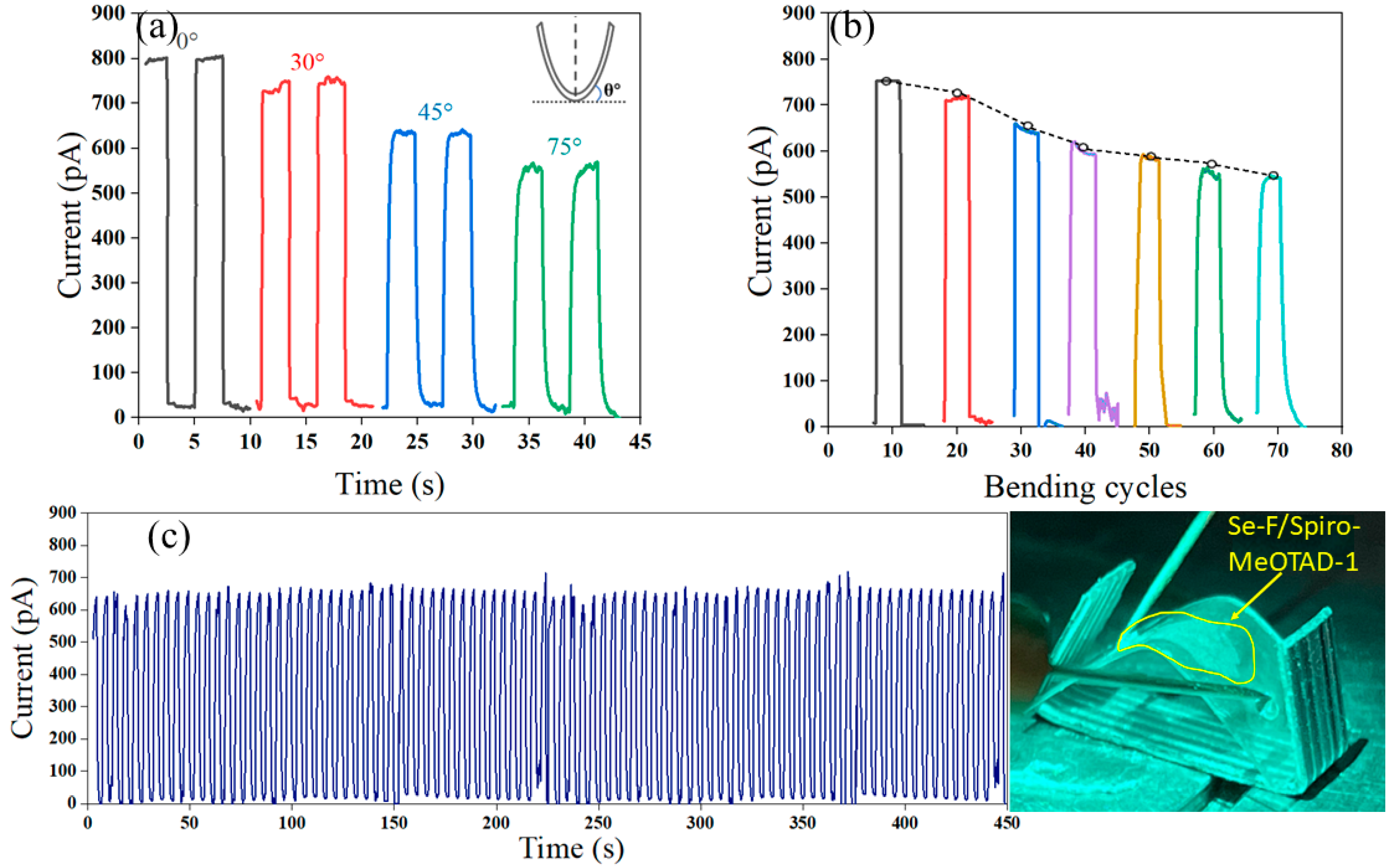
| Devices | Response Range (nm) | Bias (V) | On/Off | Responsivity (mA W−1) | Detectivity (Jones) | Rise/Fall Time (ms) | Ref. |
|---|---|---|---|---|---|---|---|
| Se/PANI | 300–700 | 0 | 1000 | 120 | 3.78 × 1011 | 0.45/2.84 | [24] |
| Se/PPy | 300–700 | 0 | 220 | 70 | 2.21 × 1011 | 0.35/16.97 | [24] |
| Se/PEDOT | 300–700 | 0 | 50 | 5.5 | 1.76 × 1010 | 1.00/9.78 | [24] |
| Sb2Se3/GaN | 250–1250 | 0 | 19.2 | 1210 | 1.2 × 109 | 0.669/0.672 | [48] |
| Sb2Se3 NTs | 400–1300 | 2 | 364 | 439 | 9.63 × 1010 | 27/27 | [49] |
| SnSe/Sb2Se3 | 400–1200 | 0 | - | 0.24 × 10−3 | - | 60/134 | [50] |
| Sb2Se3/Cds | 400–1650 | 0 | - | 2.6 | 3.25 × 1011 | 0.009/0.011 | [51] |
| Se-F/Spiro-MeOTAD-1 | 300–900 | 0 | 5000 | 109.8 | 2.98 × 1012 | 20/50 | This work |
| Se-F/Spiro-MeOTAD | 300–900 | 0 | 388 | 42.6 | 3.0 × 1011 | 25/50 | This work |
Disclaimer/Publisher’s Note: The statements, opinions and data contained in all publications are solely those of the individual author(s) and contributor(s) and not of MDPI and/or the editor(s). MDPI and/or the editor(s) disclaim responsibility for any injury to people or property resulting from any ideas, methods, instructions or products referred to in the content. |
© 2025 by the authors. Licensee MDPI, Basel, Switzerland. This article is an open access article distributed under the terms and conditions of the Creative Commons Attribution (CC BY) license (https://creativecommons.org/licenses/by/4.0/).
Share and Cite
Huang, Y.; Li, P.; Yu, X.; Feng, S.; Jiang, Y.; Yu, P. CNT:TiO2-Doped Spiro-MeOTAD/Selenium Foam Heterojunction for High-Stability Self-Powered Broadband Photodetector. Nanomaterials 2025, 15, 916. https://doi.org/10.3390/nano15120916
Huang Y, Li P, Yu X, Feng S, Jiang Y, Yu P. CNT:TiO2-Doped Spiro-MeOTAD/Selenium Foam Heterojunction for High-Stability Self-Powered Broadband Photodetector. Nanomaterials. 2025; 15(12):916. https://doi.org/10.3390/nano15120916
Chicago/Turabian StyleHuang, Yuxin, Pengfan Li, Xuewei Yu, Shiliang Feng, Yanfeng Jiang, and Pingping Yu. 2025. "CNT:TiO2-Doped Spiro-MeOTAD/Selenium Foam Heterojunction for High-Stability Self-Powered Broadband Photodetector" Nanomaterials 15, no. 12: 916. https://doi.org/10.3390/nano15120916
APA StyleHuang, Y., Li, P., Yu, X., Feng, S., Jiang, Y., & Yu, P. (2025). CNT:TiO2-Doped Spiro-MeOTAD/Selenium Foam Heterojunction for High-Stability Self-Powered Broadband Photodetector. Nanomaterials, 15(12), 916. https://doi.org/10.3390/nano15120916







